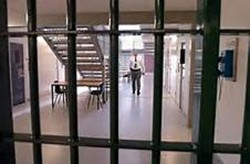In the United States there is an at-risk group that mainstream America rarely acknowledges. It is comprised of children that are presently experiencing the incarceration of a parent or continue to have difficulties due to a prior experience. There have been minimal research studies done on this group but those that have been completed illustrate a dire need for intervention and support for these children.

Incarcerated Parents and Children "Doing the Time"
For a child, the arrest and incarceration of a parent is often just the beginning of a long journey filled with heartache, confusion, fear or perhaps personal rebellion.
It is easy, in society today, for an individual to pick up the newspaper or turn on the television and become informed about an arrest, a sentencing or even the departure of someone going to prison. For most people, the thought stops there. The individual was convicted or entered into a plea agreement and the consensus is that justice has been served. Rarely will anyone question whether or not there was true justice in the proceedings and even fewer will consider the ramifications that persist for the family long after the media has moved on to the next person of interest. Sadly, the children of the person involved won’t forget as quickly and odds are, they will not move on as easily. The number of children affected is not small and they are often the “hidden victims”. They have traditionally been underserved and understudied. According to a 2008 study there were approximately 2 million children in this country that had a parent serving a sentence in a state or federal prison. The average age of the children at that time was 8, while 22 percent of the children were under the age of 5. Forty six percent of the children lived with their parent and received the majority of their care from this parent prior to the parent’s imprisonment. There are a few key challenges of parental incarceration for children and families.
Financial instability and material hardship
It is relatively simple to read the challenges but comprehending the full magnitude of each, isn’t. A person must seriously think beyond the condensed one line descriptive in order to really acknowledge and understand the many diverse aspects of each challenge.
The economic challenges that children face with parental incarceration should be easy to understand. For individuals that were in the workforce prior to incarceration, the loss of their income has an immediate impact on the family. In an era when the majority of families rely on both parental incomes to make ends meet, the incarceration and loss of income from either parent can cause serious financial burden. In situations where there was only one parental presence prior to incarceration, children are often left with other family members, usually a grandparent. This increases the often already overburdened families because government policies fail to make access to Temporary Assistance for Needy Families (TANF) easily available to grandparents or other relative caregivers. In situations where the offenders lived in poverty prior to arrest, children continue to experience similar or greater economic impoverishment once a parent enters the correctional system because they often enter poverty stricken caregivers’ homes.
In families where there is relative financial stability prior to arrest, that can quickly change. Attorney fees and related expenses can be devastating to a family and are often a detriment to continuing through until trial. From personal conversations, I know that many incarcerated men report that initially they intended to prove their innocence but after repeated postponements of court proceedings and a deluge of paperwork, motions, and petitions from the prosecutor that required response from their attorney, the fees became enormous.
By the time a plea was offered, the financial stress of continuing had become too great a burden and that was a compelling factor to just accept a plea. By the time incarceration began, the family income had already been drastically affected. .
Regardless of the family income prior to incarceration, visiting the absent parent while he/she is incarcerated causes further economic strain. Statistics from 1998 revealed that Over 50% of state inmates and 40% of federal inmates lived between 100-500 miles from their children, 43% of federal inmates lived more than 500 miles from their children. Even providing an incarcerated parent with the financial means to call home to speak to the children can cause extreme financial hardship. The cost to call out of a prison is not inexpensive and requires a landline phone service within the home of the child. In some areas and situations this is not cost feasible. These factors can, in some situations, lead to children having minimal, sporadic, or no contact with their incarcerated parent.
 | Parental Incarceration and the Family: Psychological and Social Effects of Imprisonment on Childr... Over 2% of U.S.children under the age of 18—more than 1,700,000 children—have a parent in prison. These children experience very real disadvantages when compared to their peers:... |
 | Family Arrested: How to Survive the Incarceration of a Loved One |
Instability in family relationship and structure, and residential mobility
In situations where the primary caregiver is incarcerated, children are forced to endure placement issues and further change in family structure. Other family members, usually grandparents, are the most likely candidates for either formal or informal care. Theoretically this is the most reasonable and least disruptive transition but then again, this is not always an option. In many instances the children of the incarcerated are entered into the foster care system and this can create situations where visiting or communicating with an incarcerated parent is difficult or impossible, other family ties may become severed, or legal parent-child reunification may become threatened if the parent is sentenced to a term of incarceration that exceeds the timeframes designated by the Adoption and State Families Act of 1997.
 | U.S. Criminal Justice Policy: A Contemporary Reader This current collection of essays on contemporary U.S. criminal justice policy is a timely response to the significant recent growth of policy-oriented research in the fields of... |
School behavior and performance problems and Shame, social and institutional stigma.
School behavior and performance problems are another challenge faced by children of the incarcerated but this challenge is closely intertwined with the challenge of shame, social and institutional stigma.
The experience of parental incarceration and factors leading up to it can be devastating to children and researchers have documented a variety of behavioral, psychological, emotional and educational problems in children traumatized by the arrest, separation, incarceration and absence of a parent. Responses in children have been noted in various ways including sadness, withdrawal, low self-esteem, excessive crying, depression, diminished school performance, truancy, disciplinary problems, alcohol and other drug use, running away and aggressive behavior
In 2002, Carl Mazza in the journal Families in Society made an interesting point of identifying the fact that the trauma for children often begins long before the actual incarceration of the parent. If the child is present at the time of arrest they witness the “criminalization” of their parent. This includes the parent being handcuffed, read their rights, and taken away in a police car. This trauma has been compared to the trauma of a child seeing a parent assaulted. The arrest process is frightening and confusing and the children quickly find that there may be no one they can talk to about it. A combination of parent-child separation and forced silence about the incarcerated parent due to shame on the family is believed to increase trauma in children. Children of the incarcerated are often reported to have symptoms characterized as trauma related stress and exhibited difficulty sleeping, concentrating and signs of depression or they chose to withhold their feelings because they are aware of society placing a stigma on criminal behavior. Shame and stigma distinguish incarceration from other forms of parental absence such as divorce or death though the feelings of loss can be just as, if not more so, intense. If children are not present at the time of arrest, there is often an experience of a sense of abandonment because their parent has disappeared and the truth behind the parent’s absence may actually be withheld from the child. Studies indicate that panic and confusion are common in the early stages.
Families in Society: The Journal of Contemporary Social Issues
Various Ages/Stages of Child Development
Infants of prisoners seemed to experience few direct effects on intellectual and physical development based on parental incarceration but there was significant impact on minimal bonding between the parent and infant.
The impact of parental incarceration on older children appeared to become more serious. Children between the ages of two and six seemed to have diminished ability to develop autonomy and initiative may be damaged by the trauma of the parents criminal activity and/or arrest and parent-child separation. The long term impacts of parental incarceration may be worst at this stage because the children can understand and remember traumatic events but lack the ability to understand them. Data also demonstrated that children between the ages of 7 and 10 had a greater incidence of developing aggressive behaviors. Their social adjustment was more often affected and they had difficulty getting along with others in school.
Children between the ages of 11 and 14 typically have multiple experiences with parental crime, arrest and incarceration. While many exhibited the ability to overcome the absence of a parent and developed stable, productive patterns, many others displayed maladaptive behavioral patterns and rejected any type of limitation on their behavior. The process toward developing their own identity, engage in adult work and relationships, and to become independent and self-sufficient seemed to be impeded. This was attributed in part to the fact that many adolescent children of inmates have experienced a lifetime of disruption and trauma related to the incarceration and factors leading up to it.
Maladaptive behaviors such as withdrawing emotionally in school, truancy, pregnancy, drug abuse, diminished academic performance and disruptive behavior may surface when youths experience emotional and psychological problems. Children seek cliques that are accepting of them but unfortunately they are often a negative influence. It is common, for these children to become involved in the juvenile justice system and perhaps the adult system. They become at- risk of intergenerational incarceration. This is based on the data that 50% of the youths in the correctional system have a parent in the adult system. However, the Annie E. Casey Foundation studies indicate that there is not sufficient data available to clearly determine that children of inmates are more inclined to become inmates or have problems with the law.
 | When A Parent Goes To Jail : A Comprehensive Guide for Counseling Children of Incarcerated Parents A comprehensive guide for counseling children of incarcerated parents. 46 full color illustrations. Glossary. Statistic: According to the National Association of School Psycholo... |
 | My Daddy Is in Jail: Story, Discussion Guide, and Small Group Activities for Grades K-5 "My Daddy is in Jail" is a long overdue resource for helping children cope with the incarceration of a loved one. It includes a read-aloud story, discussion guide, caregiver sug... |
Regardless of the dispute on the theory of intergenerational incarceration and the frequency, we do know that children of the incarcerated are an at-risk group and do need to be identified and supported throughout the process of their parent’s incarceration and during the period of time when the parent is released and re-entry occurs. An inmate’s re-entry into society is often a tumultuous, stressful, and difficult period of time and the adjustments to being home, obtaining employment and reestablishing family bonds can take a great deal of time and effort. This is another aspect of parental “sentencing” that children experience and should have assistance and support through as well.
 | Prisoners Once Removed: The Impact of Incarceration and Reentry on Children, Families, and Commun... Imprisonment casts a long shadow in the United States. Currently, 1.4 million individuals are behind bars in America’s state and federal prisons. For every person who goes to pr... |
Society does not frequently recognize the importance or potential long term benefit of assisting those that are incarcerated and very few probably ever think beyond the inmate. They may see his/her punishment as fair or perhaps unfair, but rarely does anyone consider that in many ways the family of the inmate has been sentenced as well. The problems and challenges the children of inmates may encounter aren’t typically considered a societal problem unless they result in a legal or financial issue for the community. Additionally, sometimes the need for specific services within the community is overlooked and unmet because the enormity of need is unrealistically minimized or not recognized at all. In Catalyst Chicago, social worker Ray Anne Alvarez was quoted, “As a social worker, I often don’t learn about these kids until they have done something. “ Simplified, there is a silent suffering on the part of the child, not recognized until long after they started acting out and someone searched for an explanation of where their pain and confusion was rooted .
The identification of this problem began in the 1980’s but was not deemed a major concern of interest until the mid to late 1990’s. Recently it appears that this issue may be sliding into the back seat of a car-load of other societal problems even though they are all interrelated and require attention and the implementation of supportive services.
There are a few programs that are impressive and many others that show great potential. I plan to highlight these in another article in the near future.
You might also like
Myths Uncovered about Southern StereotypesHollywood, politics, the media, and others choose to paint Southerners as dum...
Newly Single, Now What?Newly single and struggling? Things you can do to ease the transition from be...



 Achieving Weight Loss Goalson 04/21/2013
Achieving Weight Loss Goalson 04/21/2013
 Laundry Dutyon 04/17/2013
Laundry Dutyon 04/17/2013
 Vitamin D Deficiency and Recognizing the Symptomson 03/26/2013
Vitamin D Deficiency and Recognizing the Symptomson 03/26/2013
 The Memorable Mother's Day Cookbookon 03/21/2013
The Memorable Mother's Day Cookbookon 03/21/2013



Comments
Thankyou Mira!
This is a sobering take on how incarceration gets to be perpetuated in families. I read the whole thing and it got me thinking that yes, something needs to be done to break this intergenerational incarceration, people just can't be left to their own devices, especially if they are poor. Look forward to your next article!
Yes they are! I know in the Federal System one example is the rule of no sleeveless shirts and people, including children have been refused visitation because on a blistering hot day they have shown up wearing one. I can understand no short-shorts, halter shirts, tube tops...but a well fitting sleeveless shirt...especially on a child!!! Imagine the emotion roller coaster that creates with all the anticipation of visiting and in most cases, extended travel to get there. Add to that the demeanor of some, not all, guards.